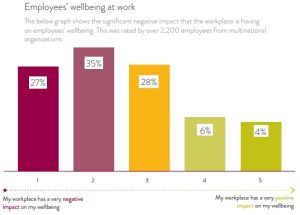 New research reveals that an alarming 62% of workers believe that their employer and workplace are having a negative or very negative impact on their wellbeing. But what’s behind this disconnect between employers and employees’ wellbeing? And what can businesses do about it?
New research reveals that an alarming 62% of workers believe that their employer and workplace are having a negative or very negative impact on their wellbeing. But what’s behind this disconnect between employers and employees’ wellbeing? And what can businesses do about it?
When it comes to improving the employee experience, forward-thinking organizations are recognizing their employees’ needs and addressing them through dynamic benefit programs that support them both inside and outside of the workplace. Bersin by Deloitte finds that organizations focused on creating a flexible and empowering workplace experience are five times more effective at improving employee engagement and retention than their peers.
Companies that want to gain a competitive advantage should consider establishing a wellness program, look for ways to go beyond traditional benefits, and digitize their HR processes. Meanwhile, businesses that do not tailor the employee experience to support the individuals in their workforce will find themselves left behind.
HR’s focus must change
Employees are looking for an employer who will have a positive impact on their day-to-day lives, but that’s not an easy task. For companies to accomplish this, HR departments need to spend more time on transformational activities that focus on culture, engagement and employer brand. HR can free up time for this by automating and digitizing more processes. This is one of the reasons adoption of global and regional shared service centers as well as global human capital management (HCM) and global benefits technology are all on the rise.
As businesses consider their digital technology strategy, they should first evaluate if they have a globally-driven strategy in place that’s aligned with their people and business strategy. Working with top companies around the globe, I’ve seen firsthand what having a well-delivered global benefits strategy in place can do. Achieve this, and organizations won’t just reduce admin time and improve compliance – they’ll see an increase in benefits engagement, which will domino into workplace engagement, and have a positive impact on how employees feel about their organizations.
Put wellness first
Wellbeing initiatives can take many forms, but flexible wellness pots, which enable employees to spend a wellbeing allowance in a way that suits them, are gaining in popularity. In a world where employees increasingly need to have individualized options, this approach enables organizations to cater to their personal preferences, whether it’s for a nutritional education or meditation classes. Surveying employees can also help to determine which wellness benefits they would value most, gym memberships for example, or counseling services to support them in times of need.
Nick Lawry, reward manager at Virgin Management, for example, believes that benefits have never been more vital in ensuring the wellbeing and peace of mind of employees, notably as part of offering a fantastic employee experience. From offering financial education to super flexible working and unlimited annual leave, Virgin is giving people the benefits and the flexibility that allow them to take control and make the choices that are best for them.
Move beyond the traditional
Promoting holistic employee wellness demands going beyond just health and fitness benefits. One Harris poll found that 82% of full-time employees are under financial stress. These financial concerns can have a significant negative impact on the mental health of employees. Our own research indicates that they would appreciate having their personal financial goals supported by their employers. Outside of salary and retirement plans, employees would like employers to support broader financial needs, such as saving to buy a home or debt management. When we consider that 67% of 26–35 year-olds have the goal to buy a home, whereas only 11% of benefits plans support this, the opportunity for employers to seize the initiative and support this need is clear.
Having flexible, customized benefits that cater to employee life goals sets companies apart and transforms them into great places to work. Pharmaceutical innovator Mundipharma recognized this, and in addition to their core offering, launched a new range pf benefits aligned to its employees’ lifestyles. This additional selection “pot” of benefits, called Flex, is designed to give employees more choice and has achieved staggering results. Since the rollout of Flex, 96% of employees have “flexed” their benefits; employee turnover has reduced by 45% in 18 months. Meanwhile, the time to fill job openings has decreased from 50 days on average to just 28. Perhaps most importantly, engagement also improved and 90% of those who flexed their benefits regularly said they’d still “be working here in a year’s time.”
Companies with an established global benefits strategy and technology that supports the implementation of this are three times more likely to see a reduction in administration errors and twice as likely to see a reduction in benefits overcharges. The implementation of those benefits further help the company’s bottom line by creating a positive, supportive working environment that reduces the current employee experience disconnect between employers and employees, attracting and retaining staff for the long haul.
Ultimately, the best companies are those creating innovative and individualized global strategies with the technology in place to deliver them. When employees are happier and healthier and enjoy being at work, they stay an engaged, happier and more productive member of your organization long-term.
